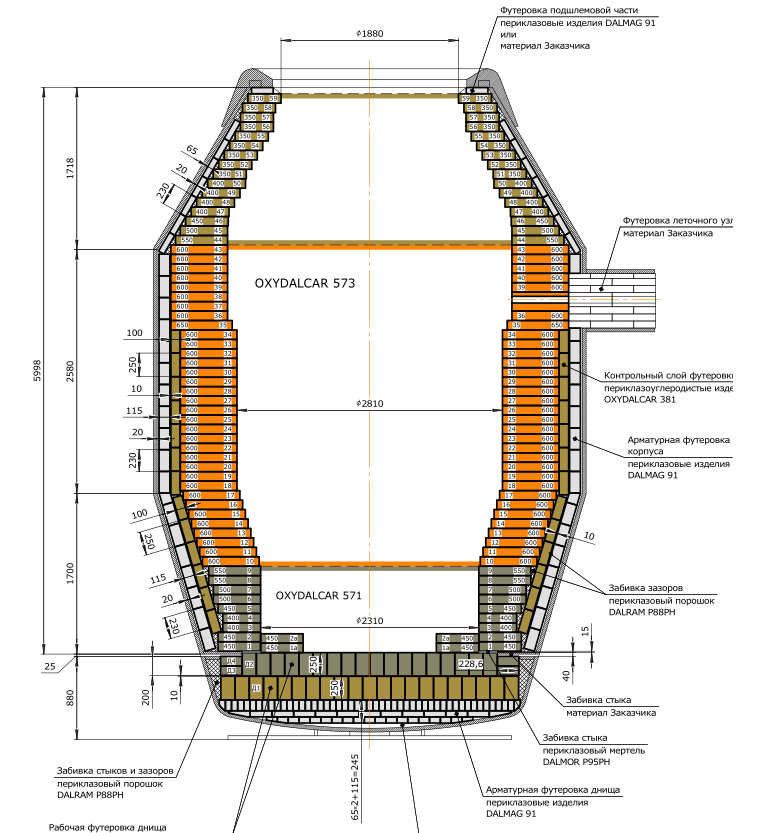Converter steelmaking is a process of steelmaking that uses mainly pig iron, scrap steel, and ferroalloys as raw materials. It does not rely on external energy sources, but instead, relies on the physical heat of the molten iron and the chemical reactions between its components to generate heat to complete the steelmaking process in the converter.
Converters can be categorized as acid or basic based on the refractory materials used, and as top-blown, bottom-blown, or side-blown based on the position of gas injection. They can also be classified as air-blown converters or oxygen-blown converters based on the type of gas used. Basic oxygen top-blown and top-bottom blown converters are the most commonly used steelmaking equipment because of their high production speed, large output, high unit production, low cost, and low investment. Converters are mainly used for the smelting of carbon steel, alloy steel, copper, and nickel.
| Insulation layer | Lightweight insulation materials such as: Lightweight mullite brick Ceramic fiber blanket Ceramic fiber board etc |
| Permanent layer | Magnesia bricks (generally refers to 95% magnesia bricks |
| Working layer | Magnesia-carbon bricks Generally with a carbon content of 8%,10%, or 14% |
| Furnace throat and furnace cap | Magnesia-carbon bricks with a carbon content of 8% |
| Furnace body | Magnesia-carbon bricks with a carbon content of 14% Magnesia-carbon bricks with a carbon content of 14% used in the impact zone (referred to as C14A) Magnesia-carbon bricks with a carbon content of 14% used in other areas (referred to as C14B) High-purity magnesia sand with a carbon content of 14% |
| Melting pool | Magnesia-carbon bricks with a carbon content of 10% Area with a height of 1700 |
| Furnace bottom | Magnesia-carbon bricks with a carbon content of 10% |
Oxygen Top Blown Furnace Steelmaking Equipment Process
The process of converter steelmaking with oxygen top blowing equipment involves loading scrap steel into the furnace according to the batching requirements, pouring in molten iron, and adding an appropriate amount of slag-forming materials such as quicklime. High-purity oxygen (with a purity of over 99%) is blown into the furnace through an oxygen lance inserted from the top. The oxygen reacts directly with the hot molten iron and removes impurities after the addition of materials.
The use of pure oxygen instead of air can overcome the disadvantages of brittleness caused by the nitrogen in the air and the loss of heat during the discharge of nitrogen. After most of the sulfur and phosphorus have been removed, the blowing process is stopped when the composition and temperature of the molten steel meet the requirements. The lance is then lifted to prepare for tapping the steel. The furnace is tilted, and the molten steel is poured into a ladle through a tap hole.
At the same time, a deoxidizer is added to remove oxygen and adjust the composition. Once the molten steel is qualified, it can be cast into steel castings or steel ingots, which can be further rolled into various types of steel products.
During the steelmaking process using oxygen top-blown converters, significant amounts of brown smoke are generated, consisting mainly of dust particles of iron oxide and high levels of carbon monoxide gas. Therefore, it must be purified and recycled comprehensively to prevent environmental pollution. The iron oxide dust particles obtained from the recovery equipment can be used for steelmaking; carbon monoxide can be used as a chemical raw material or fuel; and the heat carried by the smoke can be used to produce steam.
In addition, during steelmaking, the generated slag can also be used to make steel slag cement, and slag with high phosphorus content can be processed into phosphate fertilizer, etc. The oxygen top-blown converter steelmaking method has many advantages, such as fast smelting speed, a wide variety of steel types and good quality, as well as fast plant construction and low investment. However, the smelting process is always in an oxidizing atmosphere, and the desulfurization efficiency is poor, expensive alloy elements are also easily oxidized and lost, thus limiting the steel types and quality to some extent.
Raw materials for converter steelmaking
The raw materials for converter steelmaking are divided into metallic materials, non-metallic materials, and gases. Metallic materials include pig iron, scrap steel, and ferroalloys. Non-metallic materials include slag-making materials, fluxes, and cooling agents. Gases include oxygen, nitrogen, argon, carbon dioxide, and so on.
Non-metallic materials are added to the converter steelmaking process to remove impurities such as phosphorus and sulfur and control the process temperature. The main materials used are slag-making materials (lime, dolomite), fluxes (fluorspar, iron oxide skin), cooling agents (iron ore, limestone, scrap steel), carbon-increasing agents and fuels (coke, graphite seeds, coal, heavy oil).


